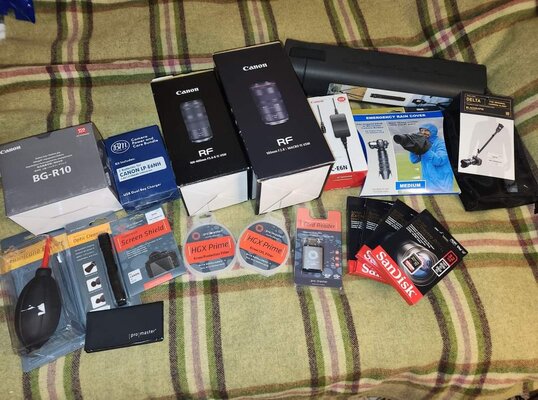After several weeks of reading, asking questions, and hitting up the local camera store, I'm almost ready. I'd love anyone's thoughts!
Enjoy photographing: wildlife, birds, flowers, gardening, travel, family
Waiting on shipping: R6 Mark II and RF24-105mm F4 L IS USM , 2 more Canon batteries, WANDRD Camera Cube, 77mm protective cover, lens hood for the RF 100-400, and Flexangle Tripod head.
Figuring I'll want a ND and ND graduated filter for the Galapagos and upcoming beach trips. I was thinking 3 stop soft edge? Am I going to want those for the 24-105 (77mm) or 100-400 (67mm) more likely?
Wondering if I'll regret not grabbing some type of flash with holiday sales. Probably needing an external HD to photo dump!
Any suggestions on anything basic that I'm missing would be appreciated! Two camera stores said the rain cover should be sufficient and that I wouldn't need lens covers? What about body protection?
I picked up Topaz on sale and will start LR when the body comes. I will have to save...and save...and save for a wide angle lens!
Thanks for any assistance!
Enjoy photographing: wildlife, birds, flowers, gardening, travel, family
Waiting on shipping: R6 Mark II and RF24-105mm F4 L IS USM , 2 more Canon batteries, WANDRD Camera Cube, 77mm protective cover, lens hood for the RF 100-400, and Flexangle Tripod head.
Figuring I'll want a ND and ND graduated filter for the Galapagos and upcoming beach trips. I was thinking 3 stop soft edge? Am I going to want those for the 24-105 (77mm) or 100-400 (67mm) more likely?
Wondering if I'll regret not grabbing some type of flash with holiday sales. Probably needing an external HD to photo dump!
Any suggestions on anything basic that I'm missing would be appreciated! Two camera stores said the rain cover should be sufficient and that I wouldn't need lens covers? What about body protection?
I picked up Topaz on sale and will start LR when the body comes. I will have to save...and save...and save for a wide angle lens!
Thanks for any assistance!


